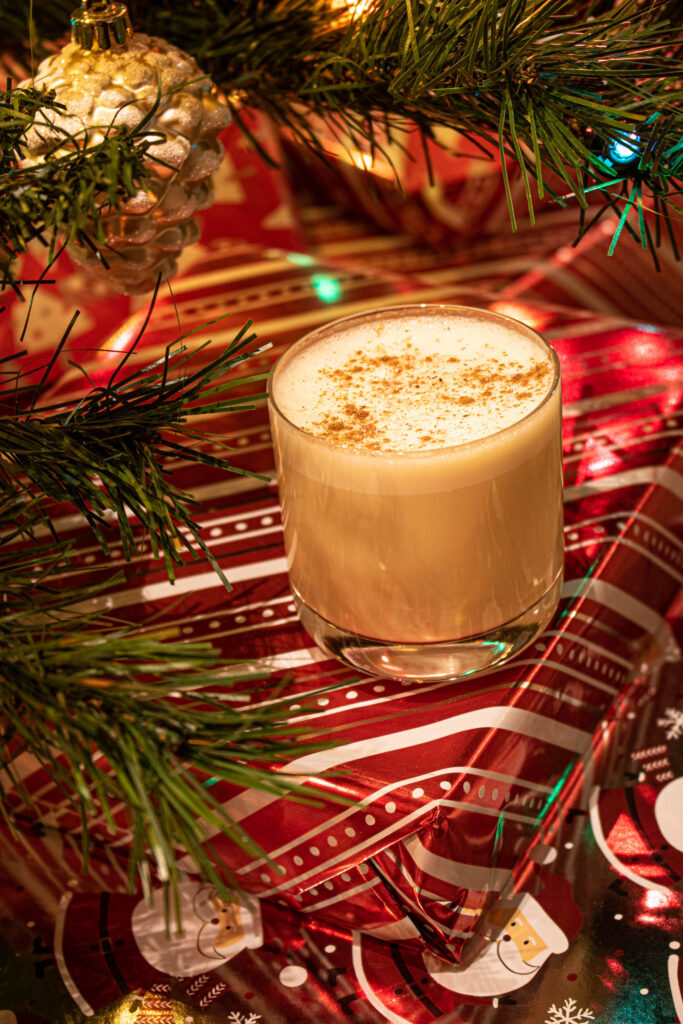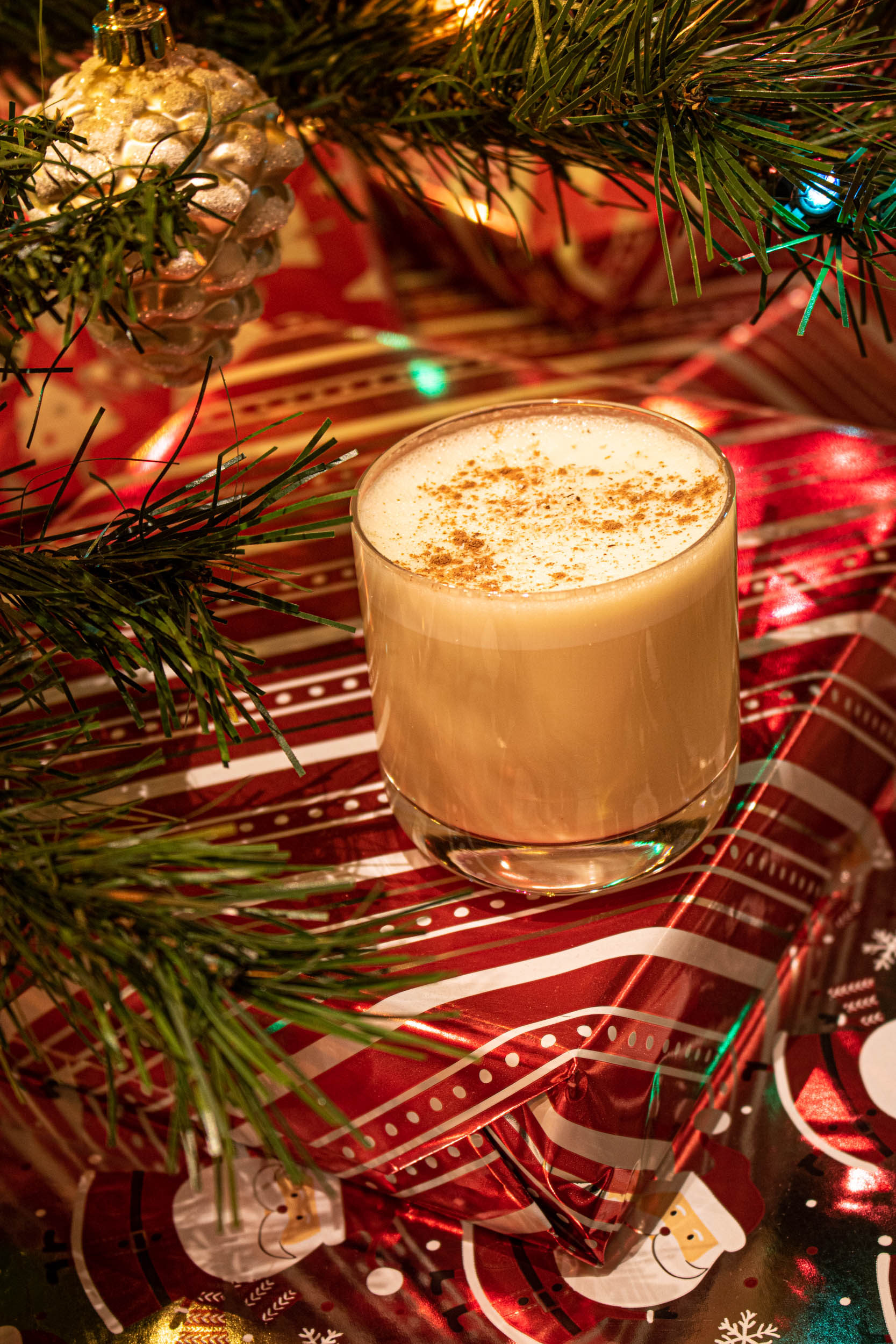
Nothing says holidays quite like Eggnog. Made of cream, sugar, and cream, Eggnog is rich, sweet, and gently slightly spiced. The idea is that it is similar to a custard. Eggnog is widely available at the store, but by making your own you have better control over the spices and ingredients that go into it. In addition, you can better control how much sugar, spice, and liquor your include. This eggnog below is designed as a quick Eggnog, for when you get a request for eggnog, but haven’t made an aged batch.
Eggnog

This eggnog is rich, full bodied, and balanced. The nose benefits from the spices which bring that beautiful holiday spice. The mix of cognac and rum captures the full mix of brown sugars and fruity notes that compliment nicely against the richness of the cream and egg. The light note of vanilla rounds out the custard like character, and the overall drink is inviting, suggesting warm fires and company visiting.
Drink Notes & Recommendations

This eggnog is a fast version, designed for when you don’t have time to make a Tom & Jerry (which features a custard base) or aged eggnog. As a result, you can expect a level of richness similar to packaged, but with a much fresher flavor and the ability to tweak it as you like it. Working with eggs and cream presents it’s own challenges, so please make sure you read through our notes below:
Construction:
- Build Order – Build this drink in the order of ingredients. This is designed to reduce the risk of curdling for both the egg and milk.
- Reducing Curdling Risks – In addition to adding the egg and cream last, you should pour the cream down the side of your vessel or over a bar spoon to avoid the height of the cream from hitting the liquor and potentially curdling. Have your ice ready to add and start shaking as soon as possible.
- Liquors – Whiskey is most commonly asked about in creating Eggnog, but you can use pretty much anything you enjoy (although we’re not sure we’d recommend gin). There’s nothing wrong with using whiskey here, but you’ll want to consider what the profile of your whiskey is. Heavily oaked or smoked whiskies may lose some of the fruity elements that work for both Cognac and Rum here. Selecting more balanced profiles or spicy whiskeys are likely to work better.
- Liquor Proof – Avoid high proof liquor of any kind here. In general the higher the proof, the easier to curdle. For those that enjoy barrel proof selections, you’ll have to be extra careful if you’d like to craft your eggnog with them.
- Straining – Due to the curdling of proteins, you may see some coagulated pieces when you strain the drink. For optimal drinking experience, double strain using both a Hawthorne and Conical Strainer. You can find our recommendations on our Recommended Equipment for Starting A Home Bar.
- Cleaning Up – Be sure to clean carefully with soap and water after making this drink as it contains both milk and egg allergens.
Ingredients:
- Rum – For constructing the drink, we tried multiple rums, and found that an aged rum from Barbados worked the best. The reason for this is that the rum adds the caramelized notes and brown sugars. The rum you’re looking for should therefore be between 5 – 10 years of age. The location matters a little less, but you’ll notice things like Jamaican funk coming through, so choose accordingly. We used Plantation’s Barbados 5 Year and Doorly X.O in our testing (the latter of which is a little heavy). Other rums that should work well include Pussers, El Pasador de Oro, and Kirk and Sweeney 12
- Cognac – Cognac will contribute some of the flavors of fruitiness and vanilla to the cocktail. While you can downgrade to brandy here, the quality difference will be noticeable. We used Pierre Ferrand 1840 here.
- Vanilla Simple Syrup – Vanilla here is going to add that custard like note that make eggnog so dessert like.
- To make: Bring 8 oz of sugar and 8 oz of water to a boil with a whole vanilla bean split lengthwise. Remove from heat and allow to cool. Once cool – add 1/4 oz of Everclear (or vodka) if desired to help stabilize and preserve shelf life. Bottle, cap, and refrigerate. Dispose of if the syrup develops any clouding or mold.
- Demerara Simple Syrup – We recommend demerara syrup here for the caramelized notes that play well with both the rum and the cognac. This is not an absolute necessity, if you’re in a pinch, you can substitute rich simple or even standard simple. The recommendation is to use a rich syrup, as the standard will add less body.
- To make: Combine 2 parts Demerara Sugar to 1 part water and bring to a simmer stirring over high heat. Remove from heat once the sugar has completely dissolved. Allow to cool and bottle. Refrigerate. The high sugar content will work to inhibit bacterial growth for an extended duration – throw out if any clouding or mold develop.
- Heavy Cream – Use heavy cream in this application as it is more resistant to curdling. When adding it, add it last, and pour it down the side to minimize the risk of shock as the cream falls into the liquor from a height.
- Egg – Yes, there is a potential risk of salmonella from raw eggs. If you are using fresh eggs that are properly handled, this risk is generally low (about 1:20,000 eggs). When making cocktails with eggs, we always recommend you use eggs that you have bought recently and wash your hands and equipment diligently after handling.
- Garnish – The garnish for this drink is freshly grated nutmeg and cinnamon. To add extra flavor to your eggnog, grate some of the nutmeg into the Eggnog prior to shaking.